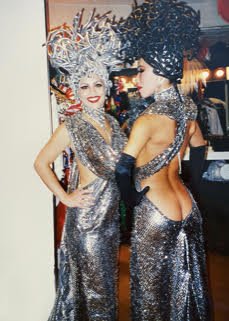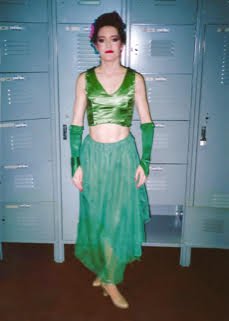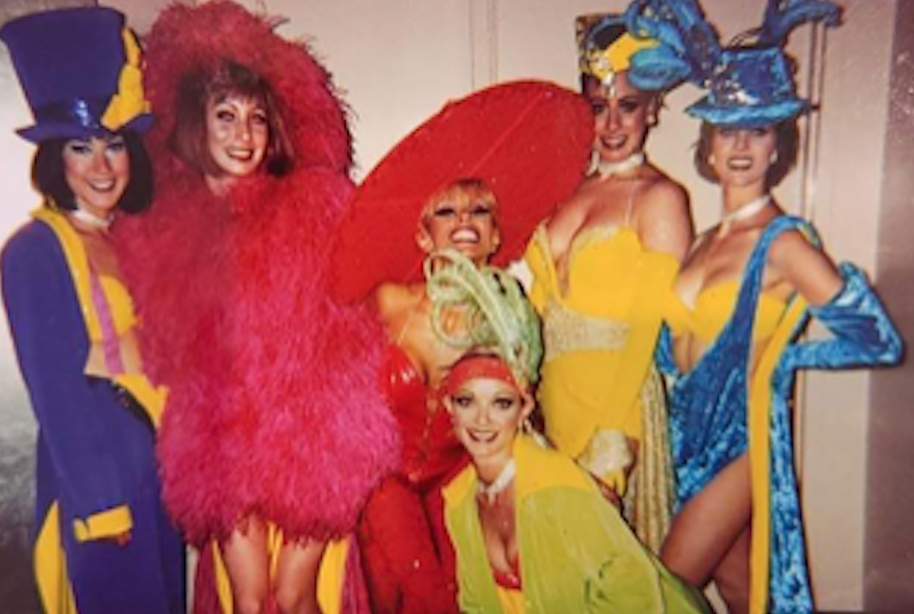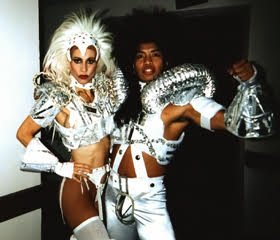Elaine Sargent – also known by her penname, E.M. Starr – is the author of Rhinestone Confidential, a memoir she wrote of her memories and experiences working behind the scenes in the showroom at Harrah’s, Reno. Within the pages, Elaine recounts the golden days when Reno was a casino town full of late-night shows. She shares the juiciest moments and mishaps from backstage at Sammy’s Showroom, Harrah’s then-hot venue for cabarets and headliners where Elaine worked a wardrobe job. Our Town Reno reporter Gaia Osborne sat down with Elaine to talk about her time at Harrah’s and experience authoring a book.
GO: Can you tell us about yourself and your experiences that informed the writing of Rhinestone Confidential?
ES: Sure! I wrote a book about my experience working backstage at Harrah’s Reno. The name of the showroom was Sammy’s Showroom. In 1992, they made a change to the closer cabaret which featured bands and then showgirl review acts, eventually deciding to close the cabaret and make it into a sportsbook. They made the headliner room into a combination. Shows were twice a night, with an added early show that was deemed good for families – the show girls were covered on top. The middle show was a headliner; Bill Medley, Phyllis Diller, Don Rickles, and many others. The late show was topless. Now, there are no more showgirl revues in Reno, or Vegas either. So, in 2020, when Harrah’s closed for good, I had some time on my hands and decided it was time to write my story. I had left Harrah’s earlier on, in 2007, and I tell the story of that in my book. I ended up with the backstage job actually through UNR. I was a journalism major, but knew immediately that I didn’t want to do hard news. I decided to focus on fashion journalism, but since they didn’t offer that at UNR I made my own study abroad program in ‘89, and moved to New York City to attend the Fashion Institute of Technology. I was enrolled in the fashion journalism program there for one semester. When I came back to Reno, I was a little down at the fact that I couldn’t continue with what I really wanted to study. My sister had told me that she took costuming as an elective, and I had no idea that was even offered. So I enrolled in Costuming 101, starting my path to costume design which I ended up minoring in. I was doing an internship and ended up at Harrah’s in a wardrobe job, which meant I was fixing the costumes, helping the entertainers get dressed backstage to make their quick changes. That job fell in my lap, and that’s how it all started.
GO: What was it like being backstage at these shows? What goes into putting on the shows and making them run smoothly?
ES: It was very exciting being backstage, even though when you do the same show over and over, night after night, it can sometimes get boring. But still, no matter what, you’re backstage, the music is thumping in your ears, and you’re having to move quickly to get people on stage. And then every once and a while, something goes wrong. We had the power go out once, a costume break apart, things like that. We even had an elevator in the middle of the stage that went up and down with the performers in it. It malfunctioned, and so if you have an elevator sticking up in the middle of the stage and a performer going on expecting the elevator to be flat, that can be a problem. Being backstage, there’s always something going on. I loved the shows that we had, almost every show was just incredibly well done. I say almost because we had one little bip where the producer decided that with Cirque du Soleil being such a hit, we should go in that direction. It was our least successful show. But the producer and director, I consider friends. Everybody in that show, the cast and crew, I consider family still and Facebook is great. We are all able to keep in touch. But yeah, the Cirque du Soleil show was not a success. The girls were dancers, not acrobats. And when I say dancers, they were highly trained. But there was crying, there were injuries. But their shows are fantastic.
GO: Were the performers in the show local girls or did they travel from other countries to come and perform at Harrah’s Reno?
ES: That’s a really good question. Most of them did come from all over the world, we had dancers from South Africa and England. But we did have a few local girls. We had two girls from Reno High become gorgeous, beautiful dancers in the shows. One of them even went on to have her own production company once the shows went away. But showgirls originated in France, with a dance teacher named Miss Bluebell. She had a troop of dancers, she called them her ‘bluebells.’ Many girls were too tall to be ballerinas, and so they would gravitate over to Miss Bluebell who had a show at The Lido in Paris. When Las Vegas decided that they wanted to feature dancers, they went to Miss Bluebell who sent over a troupe of her girls. There’s a whole fascinating history, and when I stared off writing I originally wanted to write a book about the history of the showgirl. This was in 1999 I decided I wanted to do this, but there was no internet or easy way or me to research it.
GO: Without revealing too much of your novel’s content, can you let readers in on just one of your favorite stories or anecdotes that stuck with you from your time at Harrah’s?
ES: Sure. At one point, we had a producer and his wife – he married a performer who was a fantastic singer and dancer. He wanted to feature his wife on stage changing from one blonde to another. The job that I normally did backstage, helping her undress and get dressed into another costume quickly, was going to happen onstage and in front of the audience. And I wanted to quit. I didn’t, but I just had to realize that this was part of my job even though I was wardrobe. Sometimes I had to do things with the stage crew, like pull a curtain or push a prop on or off stage. So I’d stand behind the prop, which was half a dressing room, and I’d be on stage right with a stage tech on stage left. We would push this prop into the middle of the stage and it would join together to become a dressing room. Every night, I’d stand behind this prop and beg for the power to go out or for something to happen so I didn’t have to go on stage. But I did it. And I tell you what, the dancers and singers had their own choreography, and we also had ours. We had to do the exact same thing every single night.
GO: When a new show was coming into town, what did you have to do to prepare for their arrival?
ES: That’s an excellent question. It was huge. In my book, I write about all the different producers that came to Harrah’s. But this one particular producer had the showroom for the last 8-10 years of the time I was there. He had a compound up in Seattle where they built the sets and started making the costumes. Everything would be trucked down to Reno, the crew wold unload the trucks and start finishing the sets. Wardrobe would consist of myself and my co-worker who would work together. We’d come to Harrah’s at eight in the morning and were there until midnight. The girls would be rehearsing and we’d call them down for fittings. We’d take the half-finished costumes, fit them, and do whatever we needed to get them stage ready.
GO: What prompted you to put your experiences onto paper and publish a book?
ES: I was working for the school district, which closed down in March of 2020. We ended up working from home doing distance learning through May. I didn’t have my normal routine, and like a lot of others I felt at loose ends. I would occupy myself, I bought some watercolors and started painting a little bit. Then I saw that one of my favorite authors was hosting workshops. Normally they were in LA or New York City, but because of COVID she was offering them through Zoom. I signed up and did a workshop with her, and after that I was like, I can do this. So I started writing, both in a notebook and on a computer. My daughter and I would take long walks, and I would just think about stuff I wanted to write about. We went back to school in the fall of 2020. I’m a teaching assistant, and instead of being in the classroom they had me at a help desk in the middle of the hallway directing student traffic to bathrooms since there was only one student allowed in the bathroom at a time. So I sat at this table for about four hours a day. I could read, scroll on my phone, some of the other assistants were doing adult coloring books. But I spent most of my time writing in a notebook.
Elaine’s memoir, Rhinestone Confidential, is available to purchase online at Amazon or locally in Reno at Sundance Bookstore (121 California Ave, Reno, NV 89509) and The Radical Cat (1717 S Wells Ave, Reno, NV 89502). A portion of the profits made from book sales will be given to Donate2Dance, a non-profit that collects gently worn dance shoes, costumes and dancewear to donate to dance schools in need across the country.
GO: Did you face any major challenges while writing the book? Did you have trouble remembering some of the finer details from all of the shows?
ES: Definitely. My husband (we met backstage, he was a crew member and did lights), would help answer my questions and if he didn’t know the answer, his friend would. I would message some of my former bosses, and many of the singers. I did thank (hopefully) everybody in the back of my book – I couldn’t have done it without them, there was just too many details I didn’t know. I also got a lot of research books on Harrah’s to make sure I got my facts right. I had a lot of people I could turn to for verification and help, because as a former reporter I wanted to get all my details straight.
GO: In March 2020, Harrah’s Reno closed its doors and permanently shuttered them in June following the coronavirus pandemic. How did the news affect you, seeing as you had spent so much time and had such profound experiences inside that establishment?
ES: It was completely devastating, like a loss in the family. Especially since my husband was still working there at the time. It was going to close anyway, we knew that since it was part of a deal through Caesars and the Eldorado. And then because of the coronavirus, they decided not to reopen. So we knew it was closing in August of 2020, and had made reservations at the steakhouse for one last meal at that fabulous place, and then it was gone. I’d seen all the other casinos close throughout the years, but I never thought Harrah’s would close. I will say though that in the last few years, Harrah’s struggled to keep up with renovations. When I would go there, I felt a little sad because the floor would be kind of empty.





